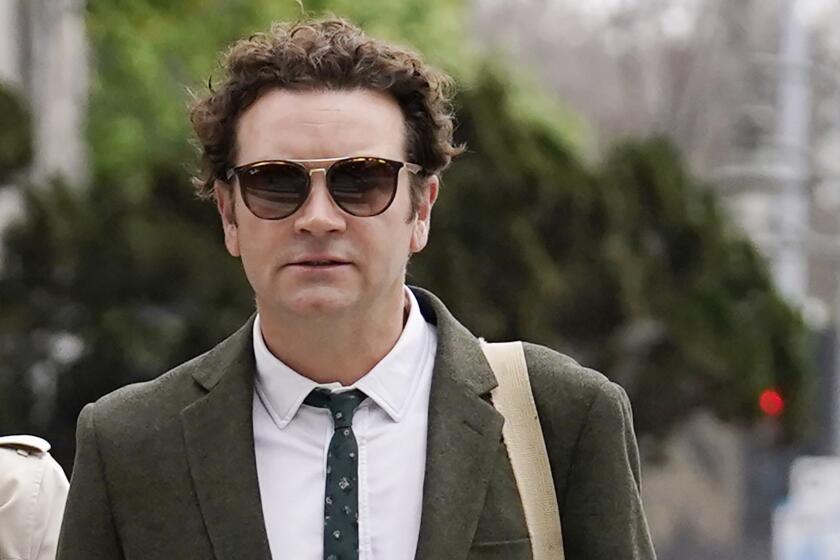Ground Zero
The frightening wail of an air-raid siren; the routine duck-and-cover drills; the ominous yellow and black fallout shelter placards--all were signs of the times as the government tried to prepare the public for nuclear attack during the Cold War.
The San Fernando Valley, with its many aerospace firms--including Rocketdyne at the west end and Lockheed Corp. on the east--would have been an important target of the Soviet Union.
Hundreds of public and private buildings were designated as fallout shelters and stocked with supplies against the unthinkable. Some shelters were nothing more than school classrooms. Others were windowless vaults and basements.
A VALLEY OF SHELTERS
There were hundreds of designated fallout shelters in 1975, as shown on this present-day San Fernando Valley map. A birdâs-eye view shows the concentration of shelters that would have provided the most protection from nuclear attack.
About the shelters:
In 1950, the year after the Soviet Union exploded its first atomic bomb, the United States established the Federal Civil Defense Administration to develop standards for fallout shelters and for warning the public about a nuclear attack. In 1961, the same year Life magazine published a letter by President John F. Kennedy urging the public to build backyard shelters, a Gallup Poll showed that many people feared they would die in an attack--even if they were in a shelter. Others feared living after a nuclear holocaust.
By the mid-1970s, there were more than 500 designated public fallout shelters in the San Fernando Valley, including parking structures, film vaults, 21 McDonaldâs restaurants and one mortuary. They could hold from as few as eight people to as many as 11,000. There was space for more than 900,000 people in shelters rated 10 to 39 times safer than being unprotected. There was room for another 440,000 people in public fallout shelters deemed 40 to 1,000 times safer than nothing.
Shelter supplies:
Staples--meant to last up to two weeks--were regularly rotated by the city of Los Angeles until the mid-1980s.
* Food, including plenty of hard candy and crackers
* Water
* Portable toilets
* First-aid supplies
* Geiger counters to measure radiation
* Lanterns
* Blankets
Effects of a nuclear explosion:
A one-megaton bomb carries with it the explosive force of 1 million tons of TNT. In the first 50 seconds after the explosion, the initial shock wave can travel about 12 miles from ground zero. High winds from such an explosion--up to 400 mph--coupled with the blast wave, would probably kill most people within three miles and some people between three and six miles from ground zero. Radiation from such an explosion can be harmful in several ways: Visible and infrared radiation can cause eye injuries and skin burns, and thermal radiation can cause second-degree burns in humans up to 11 miles from ground zero, plus ignite large fires. Early fallout that reaches the ground in the first 24 hours is highly radioactive and deadly. Delayed fallout that reaches the ground after the first day to several years after the explosion causes long-term radiation damage.
Doomsday Clock:
Since it first appeared on the cover of the Bulletin of Atomic Scientists 50 years ago, the so-called Doomsday Clock has reminded the public of nuclear threat. At various times over the past 50 years, the bulletinâs board of directors has changed the clockâs setting to reflect the current state of international security, with midnight marking nuclear disaster. Hereâs what the clock read during key years:
1947: 11:53 p.m., the year of the clockâs inception.
1953: 11:58 p.m., after the successful test of a hydrogen bomb by the United States in late 1952, the closest to midnight the clock has ever read.
1963: 11:48 p.m., after the U.S. and Soviet signing of the Partial Test Ban Treaty.
1975: 11:49 p.m., the same year as the Valley fallout shelter map.
1981: 11:56 p.m., as superpowers developed more nuclear weapons and worldwide conflicts added tension.
1991: 11:43 p.m., after the U.S. and Soviet signing of the Strategic Arms Reduction Treaty (START), the farthest from midnight the clock has ever read.
1995: 11:46 p.m., the last time the clock was reset. It was moved forward three minutes due to unratified nuclear treaties, plus instability in Russia and Third World countries.
Sources: Los Angeles County & Cities Public Shelter Directory 1975; Board of the Bulletin of Atomic Scientists; âNuclear War: The Facts on Our Survival,â by Peter Goodwin; World Book; Researched by STEPHANIE STASSEL/Los Angeles Times.
More to Read
Sign up for Essential California
The most important California stories and recommendations in your inbox every morning.
You may occasionally receive promotional content from the Los Angeles Times.










